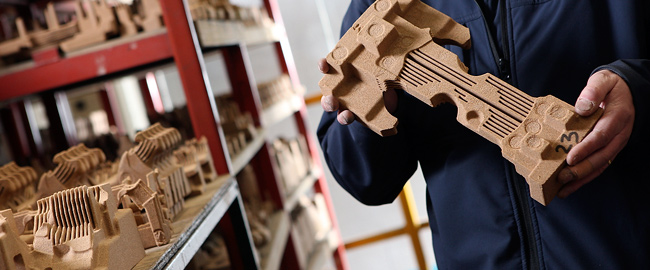Cox Powertrain, a propulsion system manufacturer based in West sussex, UK, has selected Shropshire-based Grainger & Worrall (GW) to develop main engine castings using additive manufacturing for 300 horsepower diesel outboard motors. The CXO300 is a 4.4L, twin turbocharged V8 engine which provides improved fuel efficiency for commercial vessels, leisure and sea rescue. Due to the product’s high demand, GW will leverage new technologies to produce 70 engine sets per week.
“Achieving any world-first requires the support of the best suppliers and all of Cox’s suppliers are carefully evaluated on their abilities,” said Duncan Green, Head of Procurement for Cox Powetrain. “It is important for Cox to partner with a supplier who can provide us with high quality, precision engine castings in the timescales and volumes required.”
“With Grainger & Worrall continuing to invest in technologies and techniques that enhance its current capabilities and with a long & proven track record of delivering similar products in to other premium OEMs, it makes the ideal supplier for Cox Powertrain.”
Grainger & Worrall and 3D printing
With 75 years of experience in automotive and marine casting, GW has ventured into digital manufacturing to accelerate the time to market of new products. Most recently, the company invested in a third, large scale CT scanner to ensure quality control of all its components. GW’s total investment in CT technology so far is over £1.2 million.
According to Matthias Schoeffmann, business development manager at GW, the company’s sand castings are made with the support of 3D printing. Earlier this year, GW used an S-max 3D printer from ExOne, to create large structural aluminum sand castings, acclerating the production of waterjet propulsion systems for HamiltonJet.
GW also uses COSCAST, a process in which aluminum alloy is melted and stored in an electric furnace, then carried out with an electromagnetic pump transporting the liquid metal into the sand mold. COSCAST works in tandem with GW’s digital process simulation, sand printing, rapid product validation and precision machining.
These methods will be implmeneted for the casts of the CXO300. Matthew Grainger, director of GW, stated, “The cylinder heads and both upper and lower crankcase will be produced by Grainger & Worrall as the first series production contract for the four significant engine castings.
“The innovative casting technologies employed by our company make us the ideal supplier for Cox’s ambitious programme, which requires its first engine casting deliveries to be made by year end. Our agile, flexible approach is the perfect solution for manufacturers and suppliers working to short timescales who require reduced lead-times without jeopardising quality control.”

3D sand casting
3D printed sand casts have been seen as an economical alternativie for producing casting molds without the need for complex and expensive tools. As well as GW, ExOne’s S-Max and newly relased S-Max Pro have supported companies in various applications.
In May, PumpWorks Castings, LLC, an industrial pump manufacturer and foundry, utlised the S-Max system to reduce lead time for the production of two custom parts down from 17 weeks to 8.
Prior to this, ExOne collaborated with Catalysis Additive Tooling, an Ohio-based 3D print tooling and part manufacturer, to create a new 3D printed tooling process for low-to-medium volume production parts. This began with a sand mold produced on the S-Max, which is then processed with Catalysis’ proprietary coatings. This creates a reusable tool to make a plastic, fiberglass, foam or other composite parts within traditional injection, vacuum formed or cast processes.
For the latest additive manufacturing news subscribe to the 3D Printing Industry Newsletter, follow us on Facebook and like us on Twitter.
Seeking 3D Printing Jobs? Join and advertise on our dedicated site now to reach professionals in this industry.
Featured image shows the CXO300 engine. Photo via Cox Powertrain.


